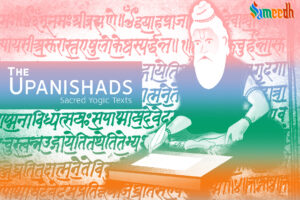The Upanishads are a collection of ancient Indian philosophical texts that form the core of Vedanta, one of the six orthodox schools of Hindu philosophy. The word “Upanishad” is derived from “upa” (near), “ni” (down), and “shad” (to sit), suggesting the idea of sitting down near a teacher to receive esoteric knowledge.

ETYMOLOGY
‘Upa’ means Near, ‘Ni’ means In Totality, and ‘Shad’ means To Sit. These scriptures are called Upanishad (sitting down closely with full attention) because the contents of Upanishad are written in the style of a conversation between a Guru and a Student sitting near the desk of the teacher. Upanishad are the scriptures that connect the Vedic knowledge with the society & traditions. Upanishad are aimed at bringing knowledge, prosperity, and enlightenment to the common people’s day-to-day lives. Every Upanishad elaborates on the knowledge covered in one particular Ved – from Rigved, Samved, Shukla Yajurved, Krishna Yajurved, and Atharvaved.
DATING AND HISTORICAL CONTEXT
The Upanishad have been written and re-written by the scholars of respective timelines. Experts believe that this process went on till 1400 CE. The first few Upanishad can be historically traced back to the 1st millennium BCE. But it is understood that the knowledge of Upanishad existed far long before that as they were transmitted from generation to generation in verbal form.
It is believed that scriptures of about 13 Upanishad were dated back to 5th century to 2nd century BCE. Upanishad such as Chandogya Upanishad, Brihadaranyak Upanishad, and Taittiriya Upanishad were among the first few Upanishad. A clear difference in their writing style with verses and proses can be observed as the next generations of Upanishad emerge.
CONTENT
All the Ved have two basic components – the knowledge part and the ritual part. Upanishad are essentially a commentary on the ‘knowledge part’ of respective Ved. They represent the Vedant tradition which is based on the ultimate conclusion or result (Ant) of the four Ved. Historians still debate over the exact number of Upanishad as there are numerous versions and renditions available – about 200 of them. The Muktikopanishad enlists about 108 Upanishad.
However, there are 10 Upanishad believed to be the principal 10 Upanishad or Dashopanishad – they include Isha, Kena, Katha, Prashna, Mundak, Mandukya, Taittiriya, Aitareya, Chandogya, and Brihadaranyaka Upanishad.
LEARNINGS
The Upanishad makes it easier to understand the knowledge concealed in the Ved. So, they cover all the subject matters which are discussed in the original Ved – that includes medicine, astrology, measurements, architecture, warfare, music & arts, grammar, metallurgy, cosmology, spirituality, and also social rituals. Upanishad shows a scientific approach to life, metaphysics and spirituality. Every Upanishad deliberates on different aspects of existence from a different point of view.
Principles such as Satyasya Satyam (The truth of truth), Neti Neti (Not this, not this.), Aham Brahmasmi (I am the Brahman), Sat-Chit-Anand (Existence, Consciousness, Bliss), etc., are discussed in Upanishad.
CULTURAL INFLUENCE
Ved form the core of Indian philosophy, and Upanishad take that knowledge to the people. Upanishad created a firm ground on which different Indian philosophical thoughts developed. Some of the most popular Mantra which are still a part of people’s daily lives. They also give a comprehensive insight into the history of Indian civilization and the Sanatan religion.
Well, now you have known how vast is the Vedic universe and how deep is the knowledge concealed within ancient Indian scriptures – click here to check out the list of other amazing Indian scriptures.
The Upanishads are also known as Vedanta (“the end of the Vedas”) as they are considered the concluding part of the Vedic literature. Here are some key points about the Upanishads:
- Philosophical and Metaphysical Content: The Upanishads explore profound philosophical and metaphysical ideas, seeking to understand the nature of reality, the self (Atman), and the ultimate reality (Brahman). They delve into the fundamental questions of existence, consciousness, and the purpose of life.
- Authorship and Composition: The Upanishads are not attributed to a single author; instead, they are a collection of teachings transmitted orally from teacher to student. They were composed over several centuries, spanning roughly from 800 BCE to 200 CE, with different Upanishads associated with different Vedic schools.
- Number and Classification: There are over 100 Upanishads, but traditionally, 108 Upanishads are recognized. Some of the principal Upanishads include the Chandogya, Brihadaranyaka, Mandukya, Katha, and Isa Upanishads.
- Teaching Methods: The Upanishads often employ dialogues between teachers (gurus) and students (shishyas) to convey their teachings. These dialogues may include stories, parables, and metaphors to illustrate profound truths.
- Central Concepts:
- Atman: The individual self or soul, considered eternal and unchanging.
- Brahman: The ultimate, unchanging reality or cosmic spirit that underlies and unites the diversity of the world. The realization of the identity between Atman and Brahman is a central theme.
- Moksh: Liberation from the cycle of birth and death (samsar) achieved through self-realization and union with Brahman.
- Yogas: The Upanishads discuss different paths (yogas) for attaining self-realization, including Jnana Yoga (path of knowledge), Bhakti Yoga (path of devotion), Karma Yoga (path of selfless action), and Raja Yoga (path of meditation).
- Impact on Hindu Philosophy: The Upanishads have significantly influenced Hindu philosophy, shaping the Vedantic tradition. They are also considered foundational texts for various schools of thought within Hinduism.
- Bhagavad Gita: While not a Upanishad itself, the Bhagavad Gita, a part of the Indian epic Mahabharat, is often considered a synthesis of Upanishadic teachings. It presents a dialogue between Lord Krushna and the warrior Arjun, addressing important philosophical and ethical questions.
The Upanishads are revered as a source of profound spiritual wisdom and are studied by seekers on the path of self-realization within the Hindu tradition.